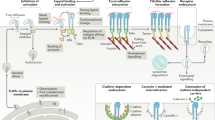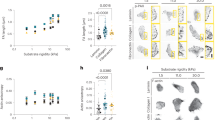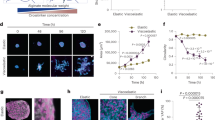Abstract
Tissue rigidity regulates processes in development, cancer and wound healing. However, how cells detect rigidity, and thereby modulate their behaviour, remains unknown. Here, we show that sensing and adaptation to matrix rigidity in breast myoepithelial cells is determined by the bond dynamics of different integrin types. Cell binding to fibronectin through either α5β1 integrins (constitutively expressed) or αvβ6 integrins (selectively expressed in cancer and development) adapts force generation, actin flow and integrin recruitment to rigidities associated with healthy or malignant tissue, respectively. In vitro experiments and theoretical modelling further demonstrate that this behaviour is explained by the different binding and unbinding rates of both integrin types to fibronectin. Moreover, rigidity sensing through differences in integrin bond dynamics applies both when integrins bind separately and when they compete for binding to fibronectin.
This is a preview of subscription content, access via your institution
Access options
Subscribe to this journal
Receive 12 print issues and online access
$259.00 per year
only $21.58 per issue
Buy this article
- Purchase on Springer Link
- Instant access to full article PDF
Prices may be subject to local taxes which are calculated during checkout




Similar content being viewed by others
References
Wang, H. B., Dembo, M. & Wang, Y. L. Substrate flexibility regulates growth and apoptosis of normal but not transformed cells. Am. J. Physiol. Cell. Physiol. 279, 1345–1350 (2000).
Engler, A. J., Sen, S., Sweeney, H. L. & Discher, D. E. Matrix elasticity directs stem cell lineage specification. Cell 126, 677–689 (2006).
Paszek, M. J. et al. Tensional homeostasis and the malignant phenotype. Cancer Cell. 8, 241–254 (2005).
Ghassemi, S. et al. Cells test substrate rigidity by local contractions on sub-micrometer pillars. Proc. Natl Acad. Sci. USA 109, 5328–5333 (2012).
Trichet, L. et al. Evidence of a large-scale mechanosensing mechanism for cellular adaptation to substrate stiffness. Proc. Natl Acad. Sci. USA 109, 6933–6938 (2012).
Plotnikov, S. V., Pasapera, A. M., Sabass, B. & Waterman, C. M. Force fluctuations within focal adhesions mediate ECM-rigidity sensing to guide directed cell migration. Cell 151, 1513–1527 (2012).
Chan, C. E. & Odde, D. J. Traction dynamics of filopodia on compliant substrates. Science 322, 1687–1691 (2008).
Schiller, H. B. et al. beta1- and alphav-class integrins cooperate to regulate myosin II during rigidity sensing of fibronectin-based microenvironments. Nature Cell Biol. 15, 625–636 (2013).
Bell, G. I. Models for the specific adhesion of cells to cells. Science 200, 618–627 (1978).
Huebsch, N. et al. Harnessing traction-mediated manipulation of the cell/matrix interface to control stem-cell fate. Nature Mater. 9, 518–526 (2010).
Humphries, J. D., Byron, A. & Humphries, M. J. Integrin ligands at a glance. J. Cell Sci. 119, 3901–3903 (2006).
Kong, F., Garcia, A. J., Mould, A. P., Humphries, M. J. & Zhu, C. Demonstration of catch bonds between an integrin and its ligand. J. Cell Biol. 185, 1275–1284 (2009).
Breuss, J. M. et al. Expression of the beta 6 integrin subunit in development, neoplasia and tissue repair suggests a role in epithelial remodeling. J. Cell Sci. 108, 2241–2251 (1995).
Allen, M. D. et al. Altered microenvironment promotes progression of pre-invasive breast cancer: Myoepithelial expression of αvβ6 integrin in DCIS identifies high-risk patients and predicts recurrence. Clin. Cancer Res. 20, 344–357 (2014).
Serra-Picamal, X. et al. Mechanical waves during tissue expansion. Nature Phys. 8, U628–U666 (2012).
Butler, J. P., Tolic-Norrelykke, I. M., Fabry, B. & Fredberg, J. J. Traction fields, moments, and strain energy that cells exert on their surroundings. Am. J. Physiol. Cell Physiol. 282, C595–C605 (2002).
Plodinec, M. et al. The nanomechanical signature of breast cancer. Nature Nanotech. 7, 757–765 (2012).
Roca-Cusachs, P., Gauthier, N. C., del Rio, A. & Sheetz, M. P. Clustering of α5β1 integrins determines adhesion strength whereas αvβ3 and talin enable mechanotransduction. Proc. Natl Acad. Sci. USA 106, 16245–16250 (2009).
Litvinov, R. I. et al. Resolving two-dimensional kinetics of the integrin alphaIIbbeta3-fibrinogen interactions using binding–unbinding correlation spectroscopy. J. Biol. Chem. 287, 35275–35285 (2012).
Bangasser, B. L., Rosenfeld, S. S. & Odde, D. J. Determinants of maximal force transmission in a motor-clutch model of cell traction in a compliant microenvironment. Biophys. J. 105, 581–592 (2013).
Hu, K., Ji, L., Applegate, K. T., Danuser, G. & Waterman-Storer, C. M. Differential transmission of actin motion within focal adhesions. Science 315, 111–115 (2007).
Riveline, D. et al. Focal contact as mechanosensor: Directional growth in response to local strain. Mol. Biol. Cell 10, 341A (1999).
sun, L., Cheng, Q. H., Gao, H. J. & Zhang, Y. W. Effect of loading conditions on the dissociation behaviour of catch bond clusters. J. R. Soc. Interf. 9, 928–937 (2012).
Novikova, E. A. & Storm, C. Contractile fibers and catch-bond clusters: A biological force sensor? Biophys. J. 105, 1336–1345 (2013).
Roca-Cusachs, P., Iskratsch, T. & Sheetz, M. P. Finding the weakest link—exploring integrin-mediated mechanical molecular pathways. J. Cell Sci. 125, 3025–3038 (2012).
Gardel, M. L. et al. Traction stress in focal adhesions correlates biphasically with actin retrograde flow speed. J. Cell Biol. 183, 999–1005 (2008).
Keselowsky, B. G., Collard, D. M. & Garcia, A. J. Integrin binding specificity regulates biomaterial surface chemistry effects on cell differentiation. Proc. Natl Acad. Sci. USA 102, 5953–5957 (2005).
Storm, C., Pastore, J. J., MacKintosh, F. C., Lubensky, T. C. & Janmey, P. A. Nonlinear elasticity in biological gels. Nature 435, 191–194 (2005).
Roca-Cusachs, P. et al. Micropatterning of single endothelial cell shape reveals a tight coupling between nuclear volume in G1 and proliferation. Biophys. J. 94, 4984–4995 (2008).
Coussen, F., Choquet, D., Sheetz, M. P. & Erickson, H. P. Trimers of the fibronectin cell adhesion domain localize to actin filament bundles and undergo rearward translocation. J. Cell Sci. 115, 2581–2590 (2002).
Shimaoka, M., Takagi, J. & Springer, T. A. Conformational regulation of integrin structure and function. Ann. Rev. Biophys. Biomol. Struct. 31, 485–516 (2002).
Roca-Cusachs, P. et al. Integrin-dependent force transmission to the extracellular matrix by alpha-actinin triggers adhesion maturation. Proc. Natl Acad. Sci. USA 110, E1361–E1370 (2013).
Laukaitis, C. M., Webb, D. J., Donais, K. & Horwitz, A. F. Differential dynamics of alpha 5 integrin, paxillin, and alpha-actinin during formation and disassembly of adhesions in migrating cells. J. Cell Biol. 153, 1427–1440 (2001).
Acknowledgements
We acknowledge support from the Spanish Ministry for Economy and Competitiveness (BFU2011-23111 and BFU2012-38146), a Career Integration Grant within the seventh European Community Framework Programme (PCIG10-GA-2011-303848), the European Research Council (Grant Agreement 242993), the Generalitat de Catalunya, Fundació La Caixa, Fundació la Marató de TV3 (project 20133330), and the Breast Cancer Campaign Tissue Bank. We thank P. Rodríguez, M. Taulés, L. Bardia, M. Rodríguez, V. González, V. Conte, A. Brugués, D. Zalvidea, D. Navajas, A. del Rio and the members of the X.T. and P.R-C. laboratories for technical assistance and discussions.
Author information
Authors and Affiliations
Contributions
A.E-A., M.D.A., J.F.M., J.L.J., X.T. and P.R-C. designed research, A.E-A., E.B., I.A., R.O. and R.S. performed experiments, M.D.A., R.S., J.J.G. and P.R-C. contributed new reagents/analytical tools, A.E-A., E.B., M.D.A., J.F.M., J.L.J., X.T. and P.R-C. analysed the data, P.R-C. implemented the computational model, and A.E-A., X.T. and P.R-C. wrote the paper. All authors read the manuscript and commented on it.
Corresponding authors
Ethics declarations
Competing interests
The authors declare no competing financial interests.
Supplementary information
Supplementary Information
Supplementary Information (PDF 2911 kb)
Supplementary Information
Supplementary Movie S1 (AVI 844 kb)
Supplementary Information
Supplementary Movie S2 (AVI 717 kb)
Supplementary Information
Supplementary Movie S3 (AVI 707 kb)
Supplementary Information
Supplementary Movie S4 (AVI 613 kb)
Rights and permissions
About this article
Cite this article
Elosegui-Artola, A., Bazellières, E., Allen, M. et al. Rigidity sensing and adaptation through regulation of integrin types. Nature Mater 13, 631–637 (2014). https://doi.org/10.1038/nmat3960
Received:
Accepted:
Published:
Issue Date:
DOI: https://doi.org/10.1038/nmat3960
This article is cited by
-
Myosin-independent stiffness sensing by fibroblasts is regulated by the viscoelasticity of flowing actin
Communications Materials (2024)
-
Physical biology of cell–substrate interactions under cyclic stretch
Biomechanics and Modeling in Mechanobiology (2024)
-
A molecular arm: the molecular bending–unbending mechanism of integrin
Biomechanics and Modeling in Mechanobiology (2024)
-
Biomechanical, biophysical and biochemical modulators of cytoskeletal remodelling and emergent stem cell lineage commitment
Communications Biology (2023)
-
The laminin–keratin link shields the nucleus from mechanical deformation and signalling
Nature Materials (2023)



